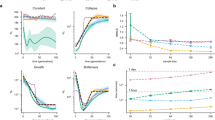Abstract
In the human genome, linkage disequilibrium (LD)—the non-random association of alleles at chromosomal loci1—has been studied mainly in regions surrounding disease genes on affected chromosomes2–6. Consequently, little information is available on the distribution of LD across anonymous genomic regions in the general population. However, demographic history is expected to influence the extent of overall LD across the genome, so a population that has been of constant size will display higher levels of LD than a population that has expanded7. In support of this, the extent of LD between anonymous loci on chromosome 4 in chimpanzees (as a model of a population of constant size) has been compared to that in Finns (as a model of an expanded population; refs 8,9) and found to exhibit more LD than in the latter population. In Europe, studies of mitochondria! (mt) DMA sequences have suggested that most populations have experienced expansion10, whereas the Saami in northern Fenno-Scandinavia have been of constant size (Table 1). Thus, in northern Europe, populations with radically different demographic histories live in close geographic proximity to each other. We studied the allelic associations between anonymous microsatellite loci on the X chromosome in the Saami and neighbouring populations and found dramatically higher levels of LD in the Saami than in other populations in the region. This indicates that whereas recently expanded populations, such as the Finns, are well suited to map single disease genes affected by recent mutations, populations that have been of constant size, such as the Saami, may be much better suited to map genes for complex traits that are caused by older mutations.
Similar content being viewed by others
References
Weir, B.S., Genetic Data Analysis (Sinauer Associates, Sunderland, Massachusetts, 1996).
Hästbacka, J. et al. Linkage disequilibrium mapping in isolated founder populations: diastrophic dysplasia in Finland. Nature Genet. 2, 204–211 (1992).
Peltonen, L., Pekkarinen, P. & Aaltonen, J. Messages from an isolate: lessons from the Finnish gene pool. Biol. Chem. Hoppe-Seyler 376, 697–704 (1995).
Jorde, L.B. Linkage disequilibrium as a gene-mapping tool. Am. J. Hum. Genet. 56, 11–14 (1995).
Kaplan, N.L., Hill, W.G. & Weir, B.S. Likelihood methods for locating disease genes in nonequilibrium populations. Am. J. Hum. Genet. 56, 18–32 (1995).
Terwilliger, J.D. A powerful likelihood method for the analysis of linkage disequilibrium between trait loci and one or more polymorphic marker loci. Am. J. Hum. Genet. 56, 777–787 (1995).
Slatkin, M. Linkage disequilibrium in growing and stable populations. Genetics 137, 331–336 (1994).
Peterson, A.C. et al. The distribution of linkage disequilibrium over anonymous genome regions. Hum. Mol. Genet. 4, 887–894 (1995).
Crouau-Roy, B., Service, S., Slatkin, M. & Freimer, N. A fine-scale comparison of the human and chimpanzee genomes: linkage, linkage disequilibrium and sequence analysis. Hum. Mol. Genet 5, 1131–1137 (1996).
Sajantila, A. et al. Genes and languages in Europe: an analysis of mitochondrial lineages. Genome Res. 5, 42–52 (1995).
Dib, C. et al. A comprehensive genetic map of the human genome based on 5,264 microsatellites. Nature 380, 152–154 (1996).
Nagaraja, R. et al. X chromosome map at 75-kb STS resolution, revealing extremes of recombination and CG content. Genome Res. 7, 210–222 (1997).
Jorde, L.B. et al. Microsatellite diversity and the demographic history of modern humans. Proc. Natl. Acad. Sd. USA 94, 3100–3103 (1997).
Thompson, E.A. & Neel, J.V., Allelic disequilibrium and allele frequency distribution as a function of social and demographic history. Am. J. Hum. Genet. 60, 197–204 (1997).
Stephens, J.C., Briscoe, D. & O'Brien, S.J. Mapping by admixture linkage disequilibrium in human populations: limits and guidelines. Am. J. Hum. Genet. 55, 809–824 (1994).
Mitchison, H.M. et al. Batten disease gene, CLN3: linkage disequilibrium mapping in the Finnish population, and analysis of European haplotypes. Am. J. Hum. Genet. 56, 654–662 (1994).
Varilo, T. et al. The age of human mutation: genealogical and linkage disequilibrium analysis of the CLN5 mutation in the Finnish population. Am. J. Hum. Genet. 58, 506–512 (1996).
Norio, R., Nevanlinna, H.R. & Perheentupa, J. Hereditary diseases in Finland. Ann. Clin. Res. 5, 109–141 (1973).
Solantie, R. Climatic conditions for the cultivation of rye with reference to the history of settlement in Finland. Fennoscandia Archaeologica V, 3–20 (1988).
Sajantila, A. et al. Paternal and maternal DNA lineages reveal a bottleneck in the founding of the Finnish population. Proc. Natl. Acad. Sci. USA 93, 12035–12039 (1996).
Raymond, M. & Rousset, F. GenePop., version 1.0. Instituté des Sciences de I'Evolution, Universitede Montpellier, France, 1994.
Quo, S.W. & Thompson, E.A. Performing the exact test of Hardy-We in berg proportion for multiple alleles. Biometrics 48, 361–372 (1992).
Tajima, F. The effect of change in population size on DNA polymorphism. Genetics 123, 597–601 (1989).
Watson, E. et al. mtDNA sequence diversity in Africa. Am. J. Hum. Genet. 59, 437–444 (1996).
Terwilliger, J.D., Zollner, S., Laan, M. & Pääbo, S. Mapping genes through the use of linkeage disequilibrium generated by genetic drift Hum. Hered. (in the press).
Author information
Authors and Affiliations
Corresponding author
Rights and permissions
About this article
Cite this article
Laan, M., Pääbo, S. Demographic history and linkage disequilibrium in human populations. Nat Genet 17, 435–438 (1997). https://doi.org/10.1038/ng1297-435
Received:
Accepted:
Issue Date:
DOI: https://doi.org/10.1038/ng1297-435
- Springer Nature America, Inc.
This article is cited by
-
Detecting a hierarchical genetic population structure via Multi-InDel markers on the X chromosome
Scientific Reports (2016)
-
Mixed Linear Model Approaches of Association Mapping for Complex Traits Based on Omics Variants
Scientific Reports (2015)
-
High similarity of genetic population structure in the false clown anemonefish (Amphiprion ocellaris) found in microsatellite and mitochondrial control region analysis
Conservation Genetics (2012)
-
A genome-wide analysis of population structure in the Finnish Saami with implications for genetic association studies
European Journal of Human Genetics (2011)
-
Genome-wide SNP analysis reveals no gain in power for association studies of common variants in the Finnish Saami
European Journal of Human Genetics (2010)





